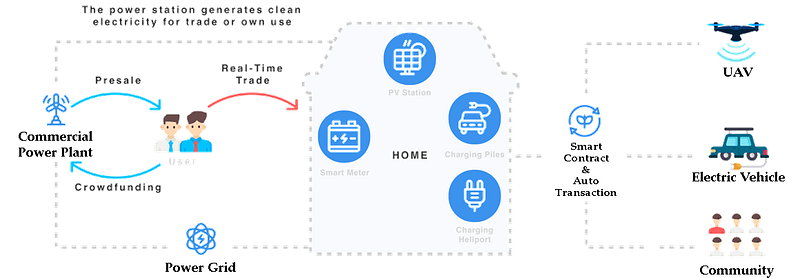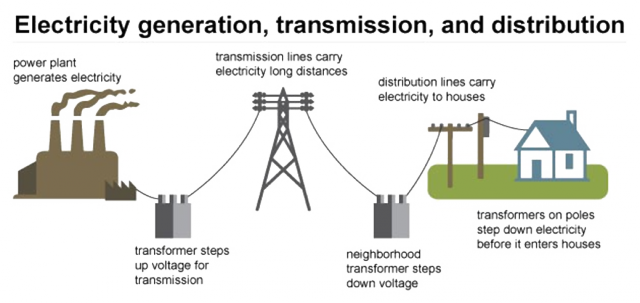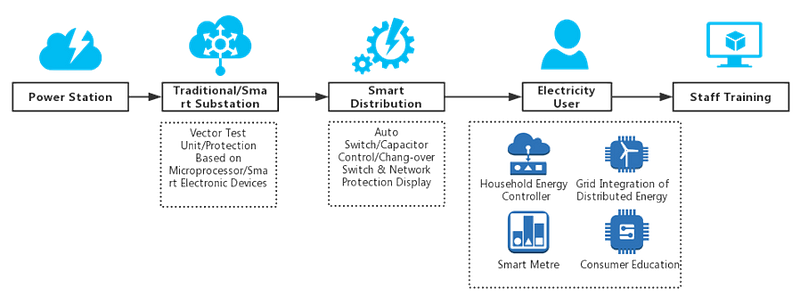ApolloChain Intelligent contract-based energy trading platform

Blockchain is a digital ledger where transactions carried out in cryptocurrency can be recorded chronologically and publicly. Blockchain has been widely studied for its energy applications. It provides innovative solutions for data interaction, information security, and creates possible deployment of these technologies in the energy trading platform. Blockchain is perfect for facilitating peer to peer energy traid in a decentralized market.
Blockchain provides reliable identification capabilities for every electrical transaction, reduces credit costs, enables fast automated settlement between entrusted parties, substantially lowers transaction costs, and effectively improves efficiency.
The Business White Book (hereinafter referred to as "paper") gives an overview of the economic characteristics of the power of some of the world's major markets; then this paper describes the core business of Apollochain, future development, and technology base; and finally, this paper reveals the current operational structure, and the Appollochain project management model.

While in the proposed solar energy, according to KPMG's research, the increase of new PV power plant capacity and will grow by 330% growth from 111.68 GW in 2012 to 3695.64GW in 2040:

Operated and managed by a centralized transaction agency is the most common practice of energy trading today. In addition to maintaining its dynamic balance, a large number of third-party agencies (eg insurance, credit, finance leases, ratings, etc.) engage in energy trading systems to ensure transaction security. The process and establishment of such loaded transactions, from a cost and security perspective, stands for huge maintenance costs, expensive third-party costs, and is dramatically vulnerable to data loss and disruption defaults.
New Apollochain Energy Trading Platform
As an innovative tool, blockchain technology intrinsically matches distributed energy in the regulated energy market. Following the reform of advanced forces and an increasingly open power retail market, distributed generation, as a rapidly growing sector, makes demand-side users have both generators and consumer identities with deep involvement in industry reform.
In the picture reveals the basic structure of the Apollochain trading platform that contains the transaction layer, extended layers and blockchain layers. Renewable energy systems are the principle of the transaction layer, while the trading parties contain power generation, power grids, distributed power plants, "smart homes" (household users and energy generators) and other renewable energy holders. Each party starts and terminates its energy transactions in this layer, then all relative data is sent to an additional layer that forms a smart contract and is eventually stored in the blockchain layer.
Above all, Apollochain implements Blockchain 3.0 technology to set up its trading platform. Aiming at all regulated and retail-oriented energy markets worldwide, Apollochain can take root in these countries and regions through current connections and resources to build fundamental users who can be generators, wholesalers, institutional or individual electricity consumers, for realizing transactions between parties, weakening centralized trading costs, and avoiding losses to government prices. In this case, smart grid with IoT (Internet of Things), AI (Artificial Intelligence) and Blockchain technology become the critical physical foundation to achieve all the above targets (together "The Energy Internet").
Smart grids enable demand-side management, and can engage in central grid networks or create micro networks by connecting end users that are geographically close to each other. Also, another important device in intelligent networks, is the intelligent power meter (otherwise known as Smart Meter). Various installations are required to obtain user power consumption data and consumption / production behavior. Based on this data, intelligent networks, by notifying the electricity costs, real-time pricing, electricity pruning schemes, etc., can reduce the scheduling costs and instruct the electricity consumer to have more rational electricity usage.

For more information :
Twitter: https://twitter.com/apollochain
Facebook: https://www.facebook.com/apollochain
Medium: https://medium.com/@apollochain
Instagram: https://www.instagram.com/aplchain_official
Telegram: https://t.me/apollochaingroup
Whitepaper: http://www.apollochain.io/WhitePaper(Business%20Version).pdf
Website: http://www.apollochain.io
Author: Putri Hanum
My Profile Link: https://bitcointalk.org/index.php?action=profile;u=2063468
ETH: 0x4a4cc6AEBC7757D4A698024a39ACf81E131BF0a0

0 Komentar:
Posting Komentar
Berlangganan Posting Komentar [Atom]
<< Beranda